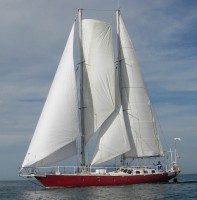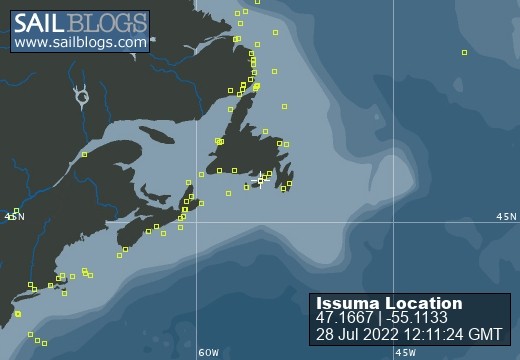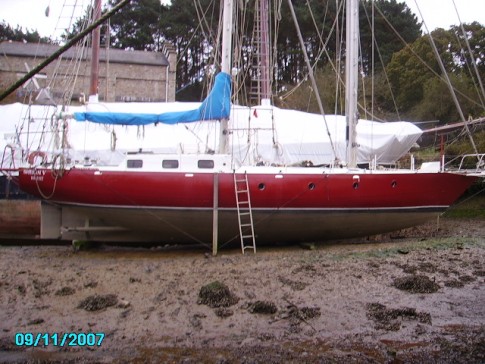

Issuma
28 July 2022
28 July 2022
08 May 2022
18 April 2022
07 April 2022
04 March 2022
17 February 2022 | Little Bay, Marystown, Newfoundland, Canada
16 February 2022
09 February 2022
06 February 2022 | Little Bay, Marystown, Newfoundland, Canada
05 February 2022 | Little Bay, Marystown, Newfoundland, Canada
01 February 2022 | Little Bay, Marystown, Newfoundland, Canada
30 January 2022 | Little Bay, Marystown, Newfoundland, Canada
25 January 2022 | Little Bay, Marystown, Newfoundland, Canada
24 January 2022 | Duricle Cove
17 January 2022
11 September 2021 | Little Bay, Marystown, Newfoundland, Canada
27 August 2021 | Grey River
26 August 2021 | Grand Bruit
26 July 2021 | Isle Valen
Hitching a Ride
28 July 2022
Richard Hudson
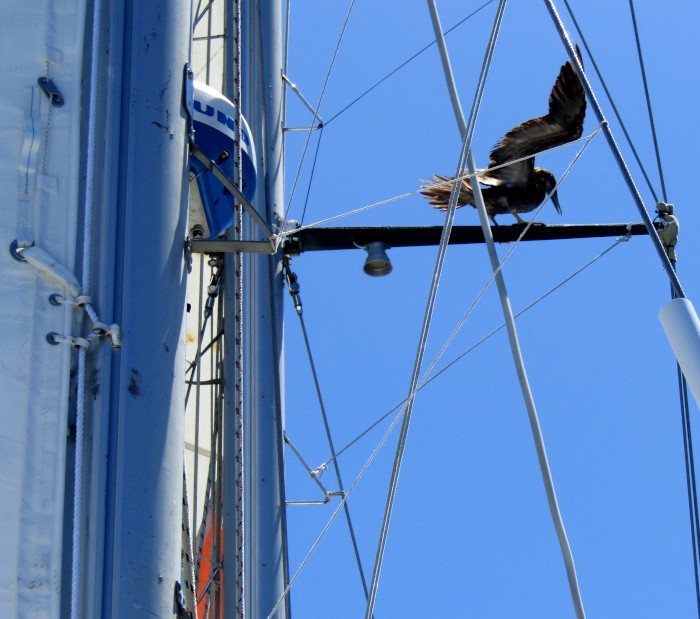
At sea, sometimes birds find places to land on the boat and rest for a while. Usually they land on the rail, which is easy to land on.
This is the first time I've seen a bird manage to fly onto the spreaders, which have lots of nearby wires that make landing difficult.
That's about 6m/20' above the deck, so the bird is getting a good place to look for fish from.
This is the first time I've seen a bird manage to fly onto the spreaders, which have lots of nearby wires that make landing difficult.
That's about 6m/20' above the deck, so the bird is getting a good place to look for fish from.
Taking a Closer Look
28 July 2022
Richard Hudson

I made several rides here, and the goats got quite used to me.
Roadblock
08 May 2022
Richard Hudson
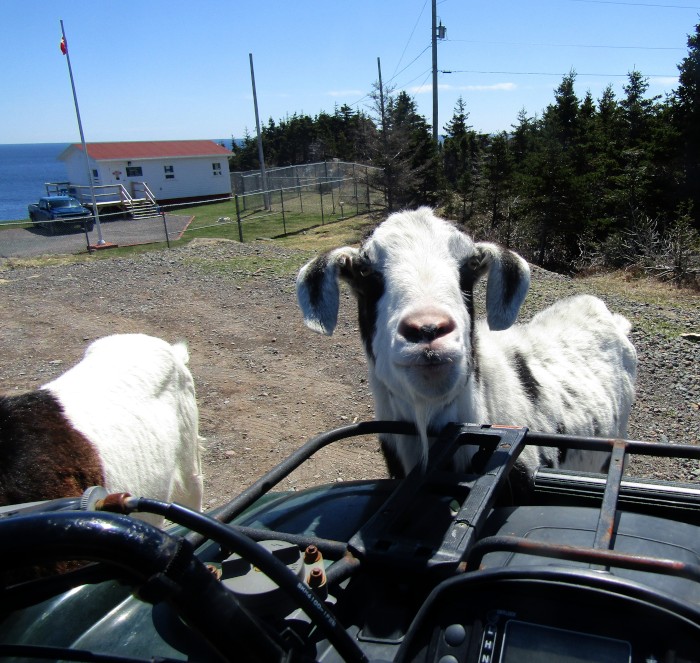
The weather was beautiful today, sunny, 10C (50F), and I couldn't resist going for an ATV ride.
I saw a moose on the road, but couldn't get the camera out in time. It's in a padded case in a ziploc bag (for dust) in the storage compartment.
At Tides Point lighthouse, some goats came over to check me out. Some of them actually climbed up on the ATV while I was sitting on it, which was interesting, but my camera's lens wasn't wide enough to show it well.
I saw a moose on the road, but couldn't get the camera out in time. It's in a padded case in a ziploc bag (for dust) in the storage compartment.
At Tides Point lighthouse, some goats came over to check me out. Some of them actually climbed up on the ATV while I was sitting on it, which was interesting, but my camera's lens wasn't wide enough to show it well.
Navigation Area
18 April 2022
Richard Hudson
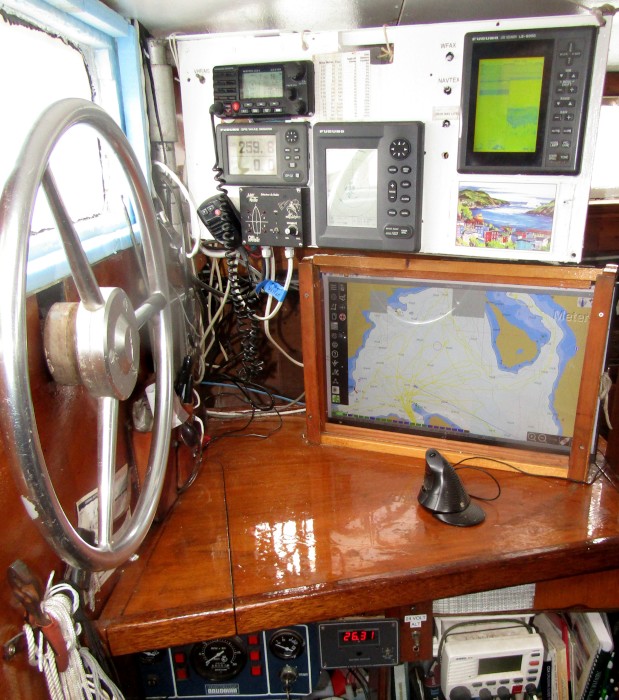
Just inside the entry to the pilothouse is the navigation table. Originally a chart table, now that I mostly navigate with the chart plotter, paper chart navigation is either done here, or on the main table, depending on the size of the chart.
The instrument panel is on a hinge, and swings so it is visible from outside. Little ropes go to little cleats to adjust the position of the panel. The instruments are inside the boat to keep them out of the weather--though most are water-resistant, I'd hate to test exactly how resistant they are with a big wave.
On the left, at the top is the VHF radio/AIS receiver, under that is the GPS, under that is the Radar Detector.
In the center at the bottom is the Radar. Above the Radar are some printed tables, one shows decimals of nautical miles to metres and feet (this is because the anchor alarm on the GPS uses decimal miles, so you need to know how large a swing radius in decimal miles is [ie 0.03 miles is 56m]).
Beside that table is a table showing how much extra distance is traveled by being off course. This is used to figure out, if we change course by X degrees to get more speed (better wind angle), is the greater speed more than the greater distance that needs to be sailed by being off course.
On the right is the Depth Sounder / Fish Finder, with art underneath. Below the panel is the chartplotter. The (paper) logbook normally sits on the table in front of the chartplotter, but isn't in the photo.
Below the table are the engine controls, a voltmeter (showing 26.31 volts), spare radio and navigation-related books.
The instrument panel is on a hinge, and swings so it is visible from outside. Little ropes go to little cleats to adjust the position of the panel. The instruments are inside the boat to keep them out of the weather--though most are water-resistant, I'd hate to test exactly how resistant they are with a big wave.
On the left, at the top is the VHF radio/AIS receiver, under that is the GPS, under that is the Radar Detector.
In the center at the bottom is the Radar. Above the Radar are some printed tables, one shows decimals of nautical miles to metres and feet (this is because the anchor alarm on the GPS uses decimal miles, so you need to know how large a swing radius in decimal miles is [ie 0.03 miles is 56m]).
Beside that table is a table showing how much extra distance is traveled by being off course. This is used to figure out, if we change course by X degrees to get more speed (better wind angle), is the greater speed more than the greater distance that needs to be sailed by being off course.
On the right is the Depth Sounder / Fish Finder, with art underneath. Below the panel is the chartplotter. The (paper) logbook normally sits on the table in front of the chartplotter, but isn't in the photo.
Below the table are the engine controls, a voltmeter (showing 26.31 volts), spare radio and navigation-related books.
Interview in Naviga magazine
07 April 2022
Richard Hudson
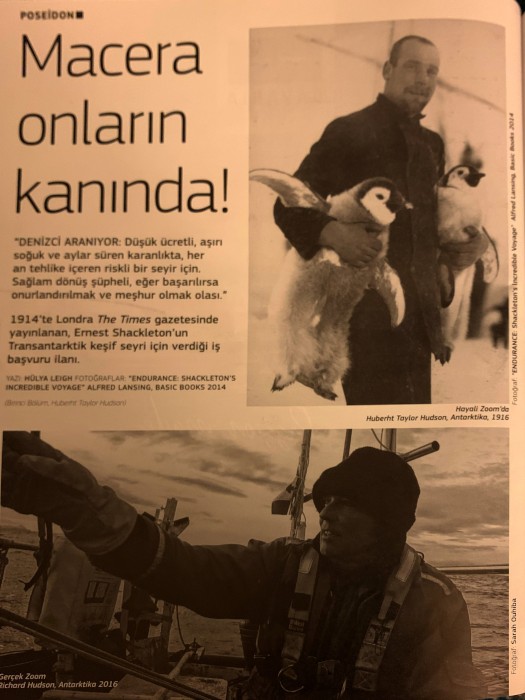
Hulya Leigh of Naviga, the Turkish sailing magazine, published an interview with me, and an imaginary interview with my great-uncle, Huberht Hudson (he was the Navigating Officer on Ernest Shackleton's Trans-Antarctic Expedition).
The article is published in the March and April issues of Naviga magazine.
A copy of the article, with English translations, is at https://www.issuma.com/rhudson/issumaboat/media/Naviga2022/PublishedAndEnglishTranslations.html
The article is published in the March and April issues of Naviga magazine.
A copy of the article, with English translations, is at https://www.issuma.com/rhudson/issumaboat/media/Naviga2022/PublishedAndEnglishTranslations.html
The Galley
04 March 2022
Richard Hudson
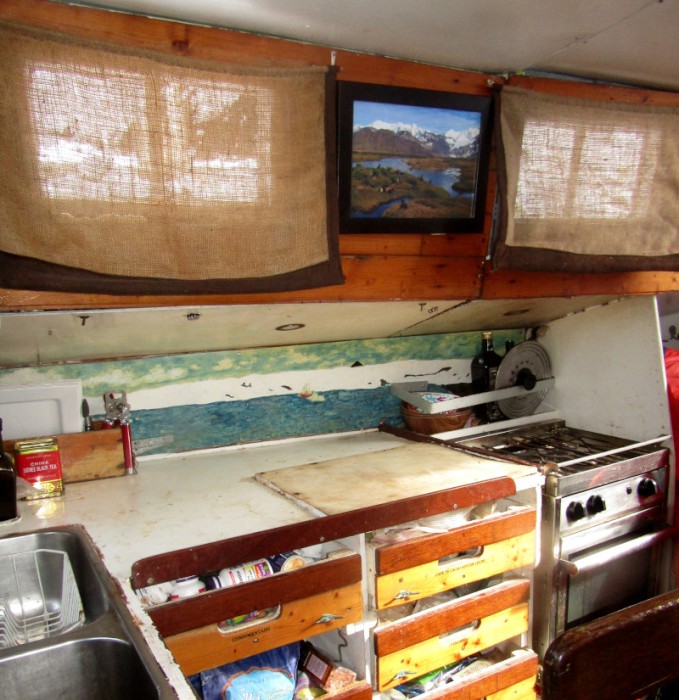
This is a view inside Issuma's pilot house, on the starboard side, showing the galley (kitchen). The photograph on the wall is of South Georgia. Behind the counter is Sarah's painting of Issuma sailing in Antarctica.
On the right, beside the propane stove, you can just see part of an orange float coat in the hanging locker.
The picture isn't wide enough to show much of the sink on the left, but it has fresh water and seawater supplied by foot pumps.
On the right, beside the propane stove, you can just see part of an orange float coat in the hanging locker.
The picture isn't wide enough to show much of the sink on the left, but it has fresh water and seawater supplied by foot pumps.
Before the snow melts
17 February 2022 | Little Bay, Marystown, Newfoundland, Canada
Richard Hudson
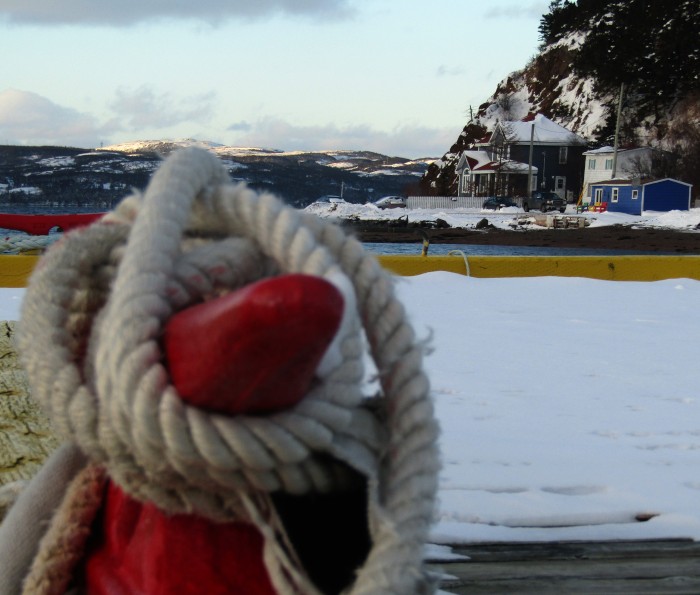
It's been cold lately, but a Violent Storm from the South today and tomorrow is going to warm the area up enough to melt all the snow.
A Violent Storm is a term used for wind speeds one step below Hurricane Force.
A Violent Storm is a term used for wind speeds one step below Hurricane Force.
Freezing up
16 February 2022
Richard Hudson
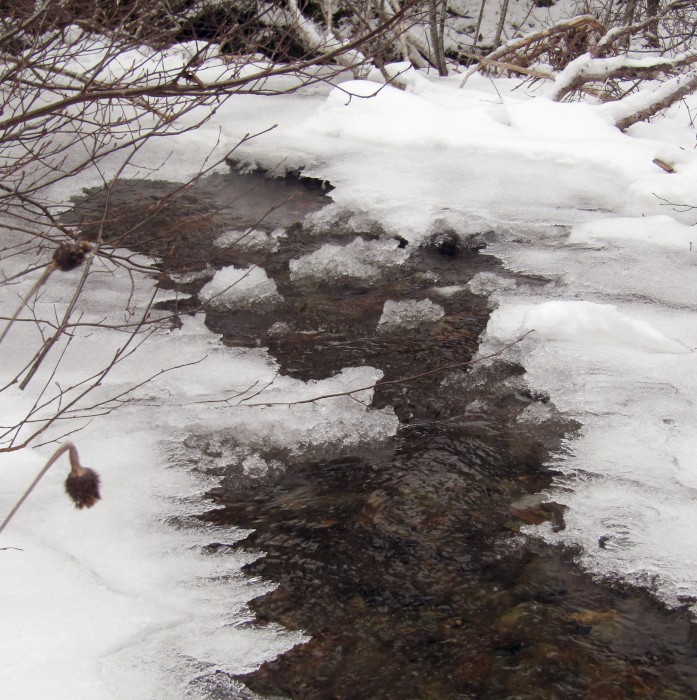
There's a nice trail nearby which was the old road to Duricle. Now it's mostly used for ATVing and hiking.
This is one of the creeks that the trail passes near, in the process of freezing up on a chilly winter afternoon.
This is one of the creeks that the trail passes near, in the process of freezing up on a chilly winter afternoon.
Eye Splicing Tools
09 February 2022
Richard Hudson
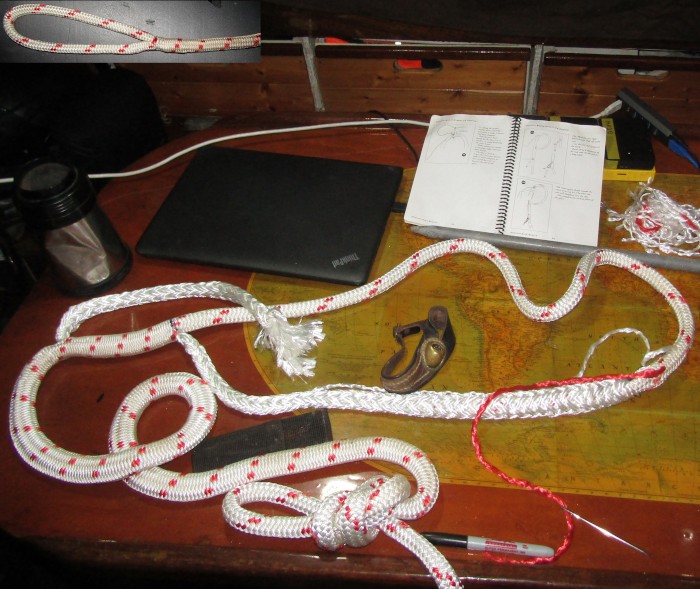
A spliced loop in the end of a rope is called an eye splice. The inset picture in the upper left corner of the photo shows what it looks like when finished.
Making a splice in double-braided rope is complicated. Double-braided rope has an outer "cover" and an inner "core".
You pull the core out of the cover, taper it, put the cover inside the core and the core back inside the cover. I haven't made a lot of these, so I still use the instruction book, seen at top.
Beside the book is a pile of yarns that have been cut from the core to taper the core. They will be discarded.
Below the book is an aluminum fid with a hollow end which is used to help get the cover inside the core and vice versa.
The sailmakers palm is for pushing the sail needle through the rope. There is a white yarn and a red yarn that I've removed from the cover, which will be sewn through the rope to help make the splice small.
The marker pen is used to mark certain places on the rope, as measurements are critical for this splice.
The knot in the rope is to keep the core and cover from moving while making the splice--the knot is removed later.
The mug of tea is required, because what kind of splice would it be without a cup of tea?
Making a splice in double-braided rope is complicated. Double-braided rope has an outer "cover" and an inner "core".
You pull the core out of the cover, taper it, put the cover inside the core and the core back inside the cover. I haven't made a lot of these, so I still use the instruction book, seen at top.
Beside the book is a pile of yarns that have been cut from the core to taper the core. They will be discarded.
Below the book is an aluminum fid with a hollow end which is used to help get the cover inside the core and vice versa.
The sailmakers palm is for pushing the sail needle through the rope. There is a white yarn and a red yarn that I've removed from the cover, which will be sewn through the rope to help make the splice small.
The marker pen is used to mark certain places on the rope, as measurements are critical for this splice.
The knot in the rope is to keep the core and cover from moving while making the splice--the knot is removed later.
The mug of tea is required, because what kind of splice would it be without a cup of tea?
Early Morning Light
06 February 2022 | Little Bay, Marystown, Newfoundland, Canada
Richard Hudson
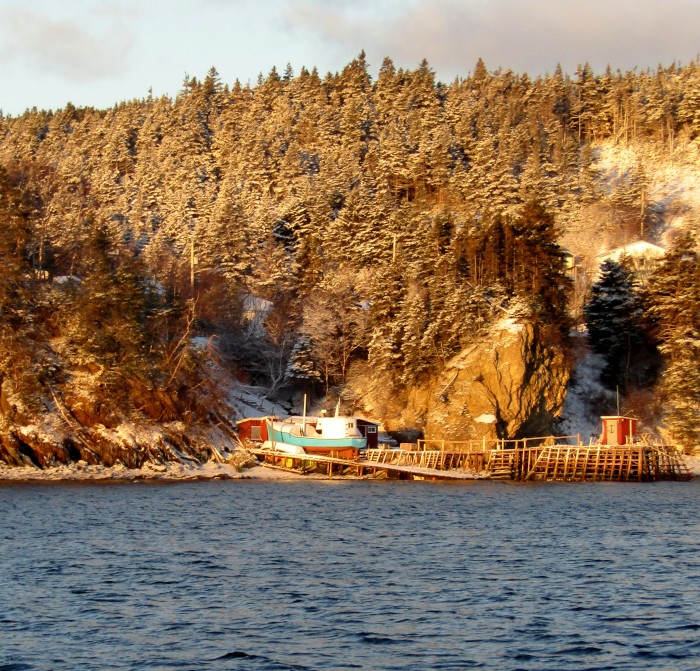
The cold NW wind is howling, the constant rain of the last two days has gone, and outside, the soft light of morning shines on the west side of Little Bay.
With a gale and freezing spray warning, it's too cold to fly the drone (bare fingers get cold too quickly), but a good time for taking pictures.
With a gale and freezing spray warning, it's too cold to fly the drone (bare fingers get cold too quickly), but a good time for taking pictures.
| Vessel Name: | Issuma |
| Vessel Make/Model: | Damien II, 15m/50' steel staysail schooner with lifting keel |
| Extra: | Designed for Antarctica. Built in France by META in 1981. Draft 1.3m/4.5' with keel up, 3.2m/10.5' with keel down. More details at http://www.issuma.com/rhudson/issumaboat/IssumaDetails.htm |
| Home Page: | http://www.issuma.com/rhudson/ |
| Social: |
